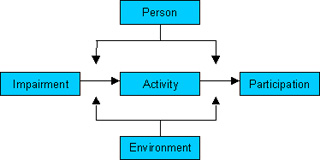 |
||||||
| Version 4.0 July 9, 2001 | ||||||
Who is disabled? This is a key question at the heart of understanding accessible design and particularly the requirements of Federal regulations. Disability can be defined in many ways. Depending on the definition, the target population for accessible design will differ. For some purposes, the definition of disability is inability to work. This is the definition used by the Social Security Administration in determining eligibility for disability payments. For other purposes, the definition of disability may be the presence of a chronic condition or impairment. This definition is used for determining eligibility for health care benefits or income tax credits. For the purposes of building design and management, however, the most appropriate definition is functional ability, or the degree to which individuals are limited in specific activities of daily living. The level of functional ability determines how much support an individual needs to maintain independence in daily life. The World Health Organization developed the International Classification of Impairment, Disability and Handicap (ICIDH) to describe the disablement process (Fig. 1).
This classification system is particularly useful in understanding the concept of architectural accessibility. In the ICIDH, impairment is an organic problem, e.g. paralysis, spinal cord injury, glaucoma, nerve damage in the ear, etc. A disability is a functional limitation caused by impairment, e.g. inability to walk, inability to see, inability to hear. A handicap, on the other hand, is not caused by impairment; it is caused by the limitations that society imposes on people with impairments or disabilities, either intentionally or unintentionally, e.g. restrictions on performing social roles of work, parenthood, etc. An intentional policy that requires a level of functional ability to obtain a job, even though the job could be done without such abilities, may be a handicap, or societal limitation, for example, requiring that a prospective employee have the ability to walk for a desk job. Likewise, architectural barriers that prevent access to a building where services are made available to the public are handicaps, although it is usually unintentional, for example, stairs at the entrance to a movie theater. The WHO is revising its ICIDH to reflect a more complete understanding of the disablement process and to reduce the negative language used in the old system. Personal and environmental factors are now considered part of the disablement process. Disability is now called "activity" and handicap is now called "participation" (Fig 2.).
Fig. 2. The New ICIDH Model of Disablement The new ICIDH recognizes that personal factors, including demographics like sex, income, minority status, and personality issues, like motivation, morale and problem solving ability, can modify the impact that impairment will have on activity or participation. For example, a 75 year-old women who is a minority group member and also has a disability is likely to encounter more barriers to social role participation than a young white male with a disability. Likewise, a person who is depressed will likely have lower levels of ability/activity than someone with high morale, even though they may have the same impairment from a medical perspective. The new ICIDH model also recognizes that the environment, both physical and social, plays a major role not only in the degree of participation that an individual will experience, but also in their functional ability. For example, a dwelling unit that limits access to the bathroom will usually require an individual with a severe impairment to have assistance in order to bathe while one that has a more supportive environment will allow the individual to be more independent. Thus, an environment free of accessibility barriers can actually increase functional ability as well as reducing the social impact of impairment. The physical environment is, in fact, part of the disablement process. All laws concerned with disability have definitions to define the target population. Public housing must comply with many accessibility regulations. Section 504 of the Rehabilitation Act of 1973 defines disability as a physical or mental impairment that substantially limits a major life activity such as seeing, hearing, speaking, walking, breathing, learning, working, performing manual tasks and caring for oneself. Under the Americans with Disabilities Act (ADA), the impairment must have a permanent or long-term impact on functional ability. The ADA also covers individuals who may be perceived to have a disability, such as a recovering alcoholic although an alcoholic who is not in recovery is not protected by the Act. These regulatory definitions are consistent with the ICIDH model of disablement. They focus on the impairment and its impact on function and participation in social roles like work. In fact, the ultimate goal of the laws is to reduce that impact so that people with disabilities, or more correctly, people with impairments, have a "level playing field" in the game of life. This will provide them an opportunity to "compete" to the best of their abilities rather than handicapping them with an environment that needlessly limits their functional ability and social participation.
|
||||||
